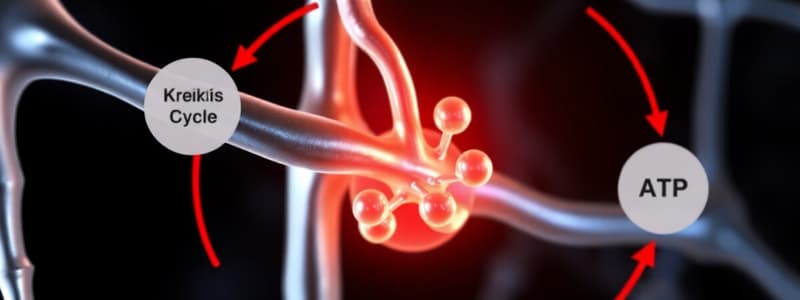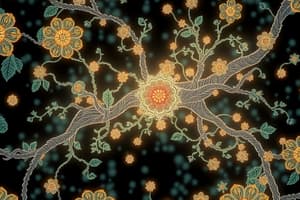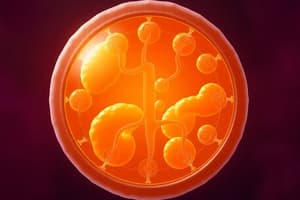Podcast
Questions and Answers
What is the main product of glycolysis?
What is the main product of glycolysis?
- 2 Acetyl CoA
- 2 pyruvate molecules (correct)
- 2 FADH₂
- 6 NADH
Where does the Krebs cycle take place?
Where does the Krebs cycle take place?
- In the endoplasmic reticulum
- In the cytoplasm
- In the inner mitochondrial membrane
- In the mitochondrial matrix (correct)
Which stage of cellular respiration directly produces ATP through the flow of hydrogen ions?
Which stage of cellular respiration directly produces ATP through the flow of hydrogen ions?
- Electron Transport Chain (correct)
- Krebs Cycle
- Link reaction
- Glycolysis
What is the final electron acceptor in the process of cellular respiration?
What is the final electron acceptor in the process of cellular respiration?
What happens in the absence of oxygen during cellular respiration?
What happens in the absence of oxygen during cellular respiration?
Flashcards
Glycolysis
Glycolysis
The first stage of cellular respiration that breaks down glucose into two pyruvate molecules. It occurs in the cytoplasm and produces a small amount of ATP and NADH.
Link Reaction
Link Reaction
The process that converts pyruvate into acetyl CoA, which then enters the Krebs cycle. It occurs in the mitochondrial matrix and produces NADH.
Krebs Cycle
Krebs Cycle
A series of chemical reactions that occur in the mitochondrial matrix. It utilizes acetyl CoA to produce ATP, NADH, and FADH2.
Electron Transport Chain
Electron Transport Chain
Signup and view all the flashcards
Chemiosmosis
Chemiosmosis
Signup and view all the flashcards
Study Notes
Cellular Respiration
- Glucose is the starting material for cellular respiration.
- Glycolysis occurs in the cytoplasm, producing 2 ATP and 2 NADH.
- Pyruvate is converted to Acetyl CoA, releasing 2 NADH.
- Acetyl CoA enters the Krebs Cycle.
- The Krebs Cycle occurs in the mitochondrial matrix; producing 2 ATP, 6 NADH, and 2 FADH2.
- Electron transport chain and chemiosmosis takes place on the inner mitochondrial membrane, using the NADH and FADH2 to produce a large amount ATP.
- Oxygen is the final electron acceptor in the electron transport chain.
- Fermentation occurs in the absence of oxygen. This produces a small amount ATP, and sometimes alcohol or lactic acid.
Studying That Suits You
Use AI to generate personalized quizzes and flashcards to suit your learning preferences.




